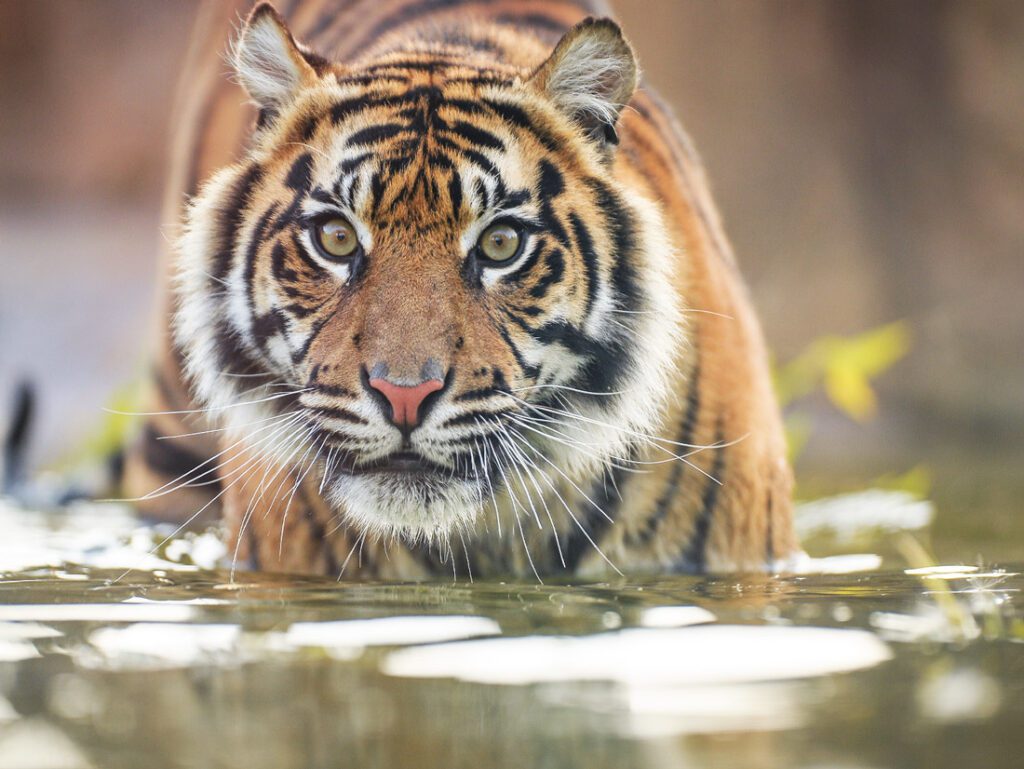Roaring through the dense jungles and captivating our imaginations, tigers are undoubtedly the kings and queens of the wild. With their striking beauty and powerful presence, these magnificent creatures come in various shapes, sizes, and colors. In this blog post, we embark on a thrilling journey to explore the different types of tigers – all nine mesmerizing subspecies that roam our planet. From the regal Bengal Tiger to the elusive Siberian Tiger, and even the extinct subspecies that once prowled our lands, get ready to uncover the secrets and wonders of these awe-inspiring felines. So, grab your binoculars and let’s delve into the captivating world of tigers, where danger and beauty intertwine in a dance of survival and splendor.
Understanding the Majestic Tigers: An Overview of All 9 Subspecies
With an imposing presence and a fearsome reputation, the tiger stands as the largest member of the cat family. The species, known scientifically as Panthera tigris, is one of the “Big Four” and boasts a total of nine subspecies. Each subspecies, unique in its characteristics and habitats, paints a remarkable picture of nature’s diversity. Yet, the awe-inspiring beauty of these majestic creatures is under threat. The chilling fact is, their population has plummeted by a staggering 95%.
We now have only 40% of the tiger population left, according to the World Wildlife Fund’s estimates.
| Type | Status |
|---|---|
| Living Subspecies | 6 |
| Extinct Subspecies | 3 |
| Total Subspecies | 9 |
Of the original nine, only six subspecies remain, while the other three have sadly succumbed to extinction. The main culprits are illegal hunting, poaching, and habitat loss. These illicit activities have significantly impacted these tiger subspecies, pushing them to the brink of extinction.
As we immerse ourselves in the exploration of each subspecies in the upcoming sections, we’ll uncover their distinguishing features, their current precarious status, and the ongoing efforts to conserve them. This journey will not only deepen our understanding of these different types of tigers but also underscore the urgency and importance of their conservation.
The Bengal Tiger
Stepping into the wild landscapes of India, Nepal, Bangladesh, and Bhutan, one can’t help but marvel at the exquisite beauty and power of the Royal Bengal Tiger. As the most common subspecies of tigers, according to the facts, they possess a population of about 2,500 to 3,750, making them an integral part of the ecosystem. However, their status as an endangered species underscores the urgency of their conservation.
These majestic creatures are adorned with a rich yellow or light orange coat that beautifully contrasts with their black or dark brown stripes. This intricate pattern etched on their hides is not just a mark of their beauty but also a powerful tool for camouflage in the wild.
Did you know? The Bengal Tiger, with males weighing between 397 to 569 pounds and females between 220 to 350 pounds, is the epitome of strength and agility in the animal kingdom.
One fascinating detail about the Bengal Tiger is the occurrence of the white tiger. Often mistaken as a separate species, this unique variant is actually a result of a mutation within the Bengal subspecies. This striking white coat, far from being a sign of albinism, is simply a rare genetic quirk that adds to the allure of these magnificent creatures.
The Bengal Tiger, also known as the King of Indian Jungles, has been a part of the Indian subcontinent since the late Pleistocene, dating from 12,000 to 16,500. Over time, the diminishing population of this subspecies due to various activities has brought the need to focus on their conservation.
As we delve further into the world of tigers, each subspecies unravels a unique story of survival and the relentless battle against extinction. Let’s journey next to the chilling terrains of Siberia and meet the largest of all tiger subspecies – The Siberian Tiger.
The Siberian Tiger: The Grandeur of the Taiga

siberian tiger
Stepping into the vast, snowy wilderness of the southeastern Russian taiga, your eyes might catch a glimpse of a grand spectacle – the Siberian tiger, or Panthera tigris altaica. Hailed as the largest of all tiger subspecies, the Siberian tiger, also known as the Amur tiger, is a unique blend of strength, grace, and raw power.
Roaming the dense forest undergrowth and stalking its prey with a stealthy prowess, the Siberian tiger is a true symbol of the wild. With its unique striped pattern adorning its regal body and a thick mane that gives it a distinguished appearance, this magnificent beast stands as a testament to the wonders of nature.
As you delve deeper into the wilderness, you may notice a striking difference in size between the genders. Adult male Siberian tigers, the titans of the taiga, can weigh an impressive 320 kg (700 lb). On the other hand, the females, while smaller, are equally formidable, weighing in at around 180 kg (400 lb).
The Siberian tiger’s habitat extends beyond Russia, spanning across China and even reaching the secluded corners of North Korea. However, their numbers are dwindling, with an estimated population of merely 450 to 500. Such a dismal number indeed casts a dark shadow on the future of this majestic tiger subspecies.
Despite the Siberian tiger’s awe-inspiring presence, it remains an endangered species, a grim reminder of the pressing need for conservation efforts. Yet, amidst the adversity, the Siberian tiger continues to rule its terrain, embodying the true spirit of resilience and survival in the face of adversity.
As we journey from the Bengal plains to the Siberian taiga, we gain a deeper appreciation of the diversity and adaptability of the tiger species. In our next section, we will explore another unique subspecies, the Indochinese Tiger, and its struggle to survive in a rapidly changing world.
The Enigmatic Indochinese Tiger
From the vast expanses of the Indian subcontinent and the snowy wilderness of Russia, our journey brings us to the dense, lush forests of Southeast Asia. Here, the Indochinese Tiger prowls majestically, marking its territory against the backdrop of a landscape as diverse and vibrant as its own striped coat.
Endemic to the region, the Indochinese Tiger has carved out its niche in countries such as Laos, Thailand, Vietnam, and Cambodia. However, just around 350 of these majestic creatures remain, classifying them as endangered.
With a physique that reflects both power and grace, the Indochinese Tiger is an awe-inspiring sight to behold. Weighing in between 150 to 195 kg (331 to 430 lbs) for males, and a slightly lighter 100 to 130 kg (220 to 290 lbs) for females, they command respect and admiration. They may not match the grand size of their Siberian and Bengal counterparts, but they certainly surpass the smaller Malayan tiger in stature.
Check out: What Eats Tigers? Discover the Top Predators That Prey on Tigers
These tigers have adapted remarkably to their environment, preferring the shelter of evergreen and deciduous forests, as well as the wet, humid climate of tropical rainforests. Their unique ability to thrive in both tropical and subtropical climates highlights their versatility and resilience. As you continue reading, you’ll discover more about the distinct characteristics and challenges faced by each subspecies in this compelling exploration of tiger diversity.
Remember, each tiger subspecies we explore carries its own tale of survival, each echoing the urgent need for conservation. As we journey through their stories, we’ll uncover the struggles and triumphs of these magnificent creatures. Join us as we traverse the globe, celebrating the beauty and strength of all nine subspecies of tigers.
The Sumatran Tiger: A Petite Powerhouse in the Tiger World

sumatran tiger
Our journey now takes us to the exotic lands of Sumatra, an Indonesian island that is the exclusive home to the smallest subspecies of tigers: The Sumatran Tiger.
Imagine a feline creature, agile and nimble, its lithe body adorned with a unique coat of brilliant orange and a bold pattern of black stripes. This is the Sumatran tiger, a subspecies that, despite its smaller size, radiates an aura of strength and resilience that matches its larger cousins.
Males of this subspecies, though smaller than their Siberian and Indochinese counterparts, carry a weight ranging from 100 to 140 kg (220 to 310 lbs). Females, true to the tiger world’s pattern, are typically smaller, weighing between 75 to 100 kg (165 to 243 lbs). This compact size aids the Sumatran tiger in navigating the dense, jungle terrain of their island home.
Did you know? The Sumatran tiger is the smallest living tiger in the world, second only to the now-extinct Bali tiger.
But, despite their fierce spirit and adaptability, the Sumatran tigers’ survival hangs in the balance. With an estimated population of only around 400 remaining in the wild, they stand on the brink of endangerment. Their habitat, once a lush, unbroken tapestry of Indonesian forests, has been fractured and reduced by human activity. In fact, about 20% of their habitat was lost between 2000 and 2012.
Every stripe, every growl, and every prowling step of the Sumatran tiger serves as a stark reminder of the delicate balance of nature and the urgent need for conservation.
South China Tiger: The Struggle for Survival

south china tiger
The tale of the South China tiger, or Panthera tigris amoyensis as it’s scientifically known, is one of desperation and resilience. Nestled in the sprawling forests of China, this subspecies is teetering on the brink of extinction. With an estimated population that barely reaches 50, these tigers find themselves in a race against time.
When you delve into their attributes, it’s hard not to admire the South China tiger. The males, weighing between 110 to 175 kg (243 to 385 lb), possess a compact yet muscular physique. This smaller body size, a trait shared with their Sumatran cousins, grants them agility and speed within their forested homes. However, the most distinguishing feature of the South China tiger is their unique pattern of stripes. Unlike their other tiger brethren, their stripes paint a distinctive outline that sets them apart.
“The South China tiger is the smallest and rarest of all the six living tiger subspecies worldwide. They are critically endangered, with just a few dozen remaining today.”
These tigers are not just symbols of strength and power but also of the fragile balance of our ecosystem. Their rapidly declining numbers are a stark reminder of the impact of human activities on wildlife. The South China tiger’s struggle for survival is a testament to the urgency of conservation efforts.
Looking at the South China tiger, one can’t help but be reminded of the plight faced by the Indochinese and Sumatran tigers, both endangered and grappling with habitat loss. The South China tiger’s story is a pressing call to action — a plea to humanity to step in and halt the march towards extinction.
Despite the grim circumstances, hope persists. Conservationists, organizations, and individuals alike are rallying to protect and preserve this unique subspecies, their efforts a beacon of light in the fight against extinction.
As we venture further into our exploration of tiger subspecies, let us carry with us the story of the South China tiger. It serves as a reminder of our responsibility to these majestic creatures and the pressing need for our engagement in their conservation.
Malayan Tiger: The Lone Ranger of Malaysia

malayan tiger
Stepping into Malaysia’s dense rainforests, you’ll encounter a unique subspecies of tiger that has adapted to thrive in this lush environment: the Malayan tiger. This particular breed of tiger, isolated from its Siberian and Bengal cousins, presents a remarkable tale of survival in the face of dwindling numbers.
With a population hovering between 150 to 200, these tigers find themselves teetering on the brink of extinction, much like the Sumatran and South China tigers. As such, they proudly bear the badge of being an endangered species.
Despite the challenging circumstances, the Malayan tiger is a formidable creature. Males boast a weight range of 47.2 to 129 kg, embodying a perfect blend of power and agility that allows them to rule their territory with an iron paw. On the other hand, females, who tip the scales between 24 and 88 kg, epitomize the grace and finesse that the tiger species is known for.
Unique to every Malayan tiger is their distinctive stripe pattern. This intricate design serves as a natural camouflage, helping these solitary hunters stay hidden in the undergrowth, ready to pounce on unsuspecting prey. A fascinating fact about these tigers is their adept swimming skills, which they use to their advantage when hunting or escaping threats.
As we delve into the story of each tiger subspecies, we begin to see a pattern emerging – a pattern of resilience, adaptability, and the will to survive against all odds. The tale of the Malayan tiger is no different; it is a testament to the magnificent creature’s spirit and its unyielding hold on life.
Read more: Are Hawks Friendly? Discover the Surprising Truth and Find Out if You Can Keep Hawks as Pets
However, the story is still being written, and it is our responsibility to ensure that it doesn’t end with the last of these majestic beasts disappearing into the shadows of extinction. Let’s continue to explore the captivating world of tigers, appreciating their diversity, recognising their struggles, and acknowledging the crucial role we play in their survival.
The Tragic Tale of the Extinct Subspecies of Tiger
It is unfortunate that the majestic tapestry of tiger subspecies has a few faded threads. Three subspecies that once roamed freely in their natural habitats have been tragically wiped out due to human activities. The Bali tiger, Javan tiger, and the Caspian tiger now exist only in the annals of history and the lamentations of conservationists.
The Lost Bali Tiger
The Bali tiger, the smallest of the three extinct subspecies, was indigenous to Indonesia’s paradise island of Bali. Known for their distinctive dark orange coat, male Bali tigers tipped the scales at around 200 lb while their female counterparts were a little lighter at 150 lb. This subspecies was the first among the Indonesian tigers to succumb to extinction, a silent testament to the relentless encroachment of their habitats.
The Vanished Javan Tiger
The Javan tiger, another of Indonesia’s native subspecies, last made its presence felt on the Indonesian island of Java in the mid-1970s. Similar to the Sumatran tiger in size, the Javan tiger was a symbol of the rich biodiversity of the island. The relentless expansion of human population, however, left them with no place to call home and eventually led to their extinction.
The Forgotten Caspian Tiger
The Caspian tiger, the largest amongst the three extinct subspecies, once ruled vast stretches of Asia. Male Caspian tigers weighed up to an impressive 550 pounds, their golden yellow fur streaked with tiny brown stripes. The 1970s marked a sad end for this magnificent creature as it was hunted to extinction, a devastating blow to the biodiversity of the region.
The extinction of these tiger subspecies underscores the destructive impact of human activities such as hunting, poaching, and habitat destruction. Let their story serve as a stark reminder of the urgent need for robust conservation efforts to protect the remaining tiger subspecies. For the sake of biodiversity and the health of our planet, we must ensure that the threads of their existence are not lost in the weave of time.
Conservation Efforts
The tiger, a creature of majestic power and beauty, is hanging by a thread. Today, the world has a mere 4,500 tigers, a stark contrast to the rich populations that once roamed the vast wilderness. The gravity of this situation is overwhelming, and it is the culmination of detrimental human activities like illegal hunting, poaching, and the loss of natural habitat due to unchecked agricultural expansion.
But there’s hope. Amid the gloom, the sparks of conservation efforts are starting to shine. With the South China tiger, the rarest of the subspecies, confined to zoos for over a decade, conservationists are not losing heart. They are working tirelessly, day and night, to prevent this regal creature from fading into the annals of extinction.
“The tiger is a symbol of nature’s power and beauty, and each subspecies adds a unique thread to the rich tapestry of our planet’s biodiversity. Losing them would be like tearing a hole in that tapestry.”
From the most populous Bengal tiger to the towering Siberian tiger, and from the petite Sumatran tiger to the critically endangered South China tiger, each subspecies has a tale to tell, a role to play in our ecosystem. The conservation of these majestic creatures is not just about saving an animal species; it is about the health of our planet, the preservation of biodiversity, and ultimately, the survival of future generations.
But more importantly, it is a test of our commitment to coexist with nature. It is a lesson in humility, a reminder that we are not the masters of this planet but mere participants in its complex web of life. The struggle to save the tiger is a poignant symbol of this battle of coexistence.
As we continue to uncover the fascinating lives of these majestic creatures, we are also reminded of our immense responsibility. The story of the tiger is not just about its survival. It is about our survival. And it is a story that needs to be told, and retold, until every last tiger is safe from the brink of extinction.
There are a total of 9 tiger subspecies.
Only six tiger subspecies are currently living.
The Bengal Tiger is also known as the Royal Bengal Tiger.
The Bengal Tiger is found in India, Nepal, Bangladesh, and Bhutan.
The population of Bengal Tigers is estimated to be between 2500 to 3750.
The Bengal Tiger is classified as an endangered species.
The Bengal Tiger has a characteristic yellow or light orange coat with black or dark brown stripes.
The male Bengal Tiger weighs between 397 to 569 pounds, while the female weighs between 220 to 350 pounds.
Bengal tigers have stout teeth with canines measuring as long as 3.0 to 3.9 inches.
Yes, Bengal tigers prefer to live solitary lives and only come together temporarily when there is plenty of food.
Siberian tigers are the largest subspecies of tigers.
Siberian tigers are found primarily in southeastern Russia.
The population of Siberian tigers is estimated to be around 450 to 500.
Siberian tigers are classified as endangered.
Siberian tigers live a solitary lifestyle and mark their presence by leaving scents on the path they cross.
Siberian tigers prefer to stalk their prey closely before pouncing on them.
Indochinese tigers are found in Southeast Asia, specifically in countries like Laos, Thailand, Vietnam, and Cambodia.
The population of Indochinese tigers is estimated to be around 350.
Indochinese tigers are considered endangered.
Indochinese tigers prefer to live in various types of forests and are nocturnal animals, being active during the night and resting during the day.
The Sumatran Tiger is found on the Island of Sumatra in Indonesia.
The population of Sumatran Tigers is estimated to be around 400.
Sumatran Tigers are classified as endangered.
Malayan Tigers communicate through growling, roaring, and puffing sounds.
Three subspecies of tigers, Panthera tigris trinilensis, Panthera tigris virgata, and Panthera tigris soloensis, are extinct.
Human activities like poaching and illegal hunting, as well as loss of natural habitat due to agriculture, are major threats to tiger populations.
There is only one species of tiger in the world, Panthera tigris, which has 9 subspecies.

